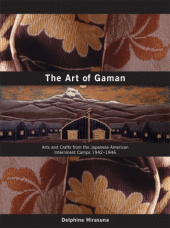Art from the Internment Camps, or Enduring the Unbearable
 For Japanese-Americans who were forced into relocation camps during World War II, everything from peach pits to bottle caps became the stuff of art.
For Japanese-Americans who were forced into relocation camps during World War II, everything from peach pits to bottle caps became the stuff of art.
They found animal traps in the brush and melted them down to make knives. A length of sewer pipe, etched with plum blossoms and small birds, became a vase. Shells from prehistoric seabeds were brushed off, bleached, and meticulously pieced together to form roses, lilacs, and even Mickey Mouse.
These pieces appear in the exhibit The Art of Gaman: Arts and Crafts from the Japanese American Internment Camps, 1942-1946, which runs through January 30 at the Renwick Gallery in Washington.
After the bombing of Pearl Harbor, the U.S. government sent more than 100,000 Japanese-Americans on the West Coast to war relocation camps in remote areas such as the Utah desert and the Arkansas swamps. They were farmers, shopkeepers, professors, housewives, dentists. Even orphanages were raided for toddlers of Japanese ancestry.
Once at camp, a half-dozen families might spend three years huddled together in a barrack where only beds were provided.
Craft, then, was something of a necessity. They needed chairs, for starters, and bureaus and washboards. One chest of drawers on display is beautifully inlaid with whorled, red-brown sections of manzanita wood.
Beyond the basics, talented internees stepped in to teach skills such as embroidery, watercolor, and woodwork. They supplemented their scrap materials with mail-order art supplies and back issues of National Geographic, from which they painted detailed, lifelike birds. One 75-year-old taught some 650 needlepoint students.
In 1945, three years after the War Relocation Authority forced them into camps, the internees began returning home. Some would pursue art professionally; many returned to work as fishermen and grocers and left their days of woodcarving behind.
The Art of Gaman is a moving testament to the men and women who embodied the spirit of gaman: “enduring the seemingly unbearable with patience and dignity.”
———————————————————–
You can view pieces from the exhibit and comments from visitors on the Renwick site. Also of interest are posts on the Smithsonian American Art Museum blog about the genesis of the exhibit and the internment of the famous sculptor Isamu Noguchi.
One of the artists received a plaque from his local Arab-American organization for speaking out against prejudice and discrimination after 911.
We saw movies about the exhibit at work as part of Pacific American Heritage month.
Written by asianclassicsproject
July 23, 2010 at 7:02 pm
Posted in America
Tagged with American crafts, gaman, internment, Renwick Gallery, Smithsonian American Art Museum, War Relocation Authority
One Response
Subscribe to comments with RSS.
Arkansas also held two Internment Camps during WWII; These facilities held the lives of hundreds and hundres in limbo till after the conclusion of the war. A local Arkansas art teacher saved the paintings and small sculptures of the Japanese-Americans. Decades passed before the pieces were shown – were shared – with the public. We are all grateful for her wisdom, patience and understanding. These tangible pieces from that era were essentially memories-you-could-hold-in-your-hand — treasured reminders of both the good and bad times of their lives. Today, these artworks are considered priceless, historical pieces and have been given honored displays in the state.
Audrey Burtrum-Stanley
October 15, 2011 at 9:18 pm